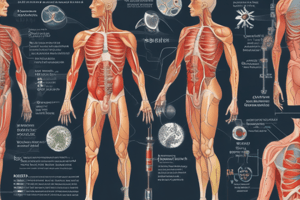Podcast
Questions and Answers
If a solution has a pH between 8 and 14, it is classified as:
If a solution has a pH between 8 and 14, it is classified as:
- Acidic
- Amphoteric
- Neutral
- Basic (correct)
Which of the following substances is an example of a soluble base or alkali?
Which of the following substances is an example of a soluble base or alkali?
- Carbon dioxide (CO2)
- Sodium hydroxide (NaOH) (correct)
- Acetic acid (CH3COOH)
- Hydrochloric acid (HCl)
What is the characteristic property of alkalis?
What is the characteristic property of alkalis?
- They are insoluble in water
- They release hydroxide ions (OH-) in aqueous solutions (correct)
- They release hydrogen ions (H+) in aqueous solutions
- They have a pH less than 7
Which of the following equations represents the dissociation of a soluble base in water?
Which of the following equations represents the dissociation of a soluble base in water?
What is the pH range of a solution that is considered alkaline?
What is the pH range of a solution that is considered alkaline?
Which of the following statements correctly describes the relationship between an acid and its conjugate base?
Which of the following statements correctly describes the relationship between an acid and its conjugate base?
If a diprotic acid, H₂A, ionizes completely in water, what would be the pH of the resulting solution?
If a diprotic acid, H₂A, ionizes completely in water, what would be the pH of the resulting solution?
Which of the following statements correctly describes the strength of a triprotic acid?
Which of the following statements correctly describes the strength of a triprotic acid?
For a monoprotic acid, HA, which of the following expressions represents the acid ionization constant (Ka)?
For a monoprotic acid, HA, which of the following expressions represents the acid ionization constant (Ka)?
If a weak acid, HA, has a Ka value of 1.0 × 10⁻⁵, what can be inferred about the strength of its conjugate base, A⁻?
If a weak acid, HA, has a Ka value of 1.0 × 10⁻⁵, what can be inferred about the strength of its conjugate base, A⁻?
Flashcards
What is a basic solution?
What is a basic solution?
A solution with a pH greater than 7 is considered basic or alkaline.
Example of a soluble base?
Example of a soluble base?
Sodium hydroxide (NaOH) is a soluble base that dissolves in water to release hydroxide ions (OH-), making the solution alkaline.
What are alkalis?
What are alkalis?
Alkalis are bases that dissolve in water to release hydroxide ions (OH-) in solution.
Dissociation of a soluble base?
Dissociation of a soluble base?
Signup and view all the flashcards
pH of an alkaline solution?
pH of an alkaline solution?
Signup and view all the flashcards
Relationship between an acid and its conjugate base?
Relationship between an acid and its conjugate base?
Signup and view all the flashcards
pH of a completely ionized diprotic acid?
pH of a completely ionized diprotic acid?
Signup and view all the flashcards
Strength of a triprotic acid?
Strength of a triprotic acid?
Signup and view all the flashcards
Acid ionization constant (Ka)?
Acid ionization constant (Ka)?
Signup and view all the flashcards
Conjugate base of a weak acid?
Conjugate base of a weak acid?
Signup and view all the flashcards




